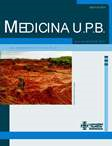Cultivo de células madre limbares en membrana amniótica para reconstrucción de tejido corneal: una comparación de dos métodos
Contenido principal del artículo
Resumen
Objetivo: Obtener un cultivo celular de células del limbus corneal en membrana amniótica como soporte por dos métodos diferentes, suspensión y explante, para obtener datos de confluencia, viabilidad y diferenciación en ambos métodos.
Métodología: Muestras de LSC (limbal stem cells, por sus siglas en inglés) fueron obtenidas de 16 donantes cadavéricos. Se realizaron seis cultivos de cada muestra, 3 por el método de suspensión y 3 por el método de explante, todo por triplicado. Como control negativo se utilizó membrana amniótica sin LSCs. Las células fueron cultivadas con SHEM, 37°C, 5% CO2 y 95% de humedad. Los cultivos fueron mantenidos por 14 días con un recambio de medio cada 3 días. El día 14 los cultivos fueron analizados para evaluar viabilidad con azul de tripano, confluencia por microscopio y la diferenciación celular con Inmunohistoquímica para detectar citoqueratina 3/12.
Resultados: Como resultado de los experimentos mencionados anteriormente, para los métodos de suspensión y explante, se encontró una viabilidad de 98.92% y 98.32%, una confluencia de 55.95% y 48.27%, una concentración celular de 38.83x104 células/ml y 36.484x104 celulas/ml, y una diferenciación de 22.93% y 16.55%, respectivamente.
Conclusiones: Aunque éste estudio compare dos métodos, cultivos en suspensión de LSC y cultivo en explante de LSC, ambos con membrana amniótica como soporte, nosotros encontramos una pequeña diferencia en ellos. Como resultado, el cultivo en suspensión fue mejor que el explante, sin embargo los resultados no son conclusivos, por lo tanto es necesario realizar más investigaciones en este campo para lograr una conclusión con respecto al desempeño de estos dos métodos.
Referencias
Dartt D. Control of mucin production by ocular surface epithelial cells. Exp Eye Res. 2004;78(2):173-185.
Yu F, Yin J, Xu K, Huang J. Growth factors and corneal epithelial wound healing. Brain Res Bull. 2010 Feb;81(2-3):229-235.
Nishida K, Kinoshita S, Ohashi Y, Kuwayama Y, Yamamoto S. Ocular surface abnormalities in aniridia. Am J Ophthalmol. 1995 Sep;120(3):368-375.
Kinoshita S, Adachi W, Sotozono C, Nishida K, Yokoi N, Quantock AJ, et al. Characteristics of the human ocular surface epithelium. Prog Retin Eye Res. 2001 Sep;20(5):639-673.
Shortt AJ, Secker GA, Notara MD, Limb GA, Khaw PT, Tuft SJ, et al. Transplantation of ex vivo cultured limbal epithelial stem cells: a review of techniques and clinical results. Surv Ophthalmol. 2007 Sep-Oct 2007;52(5):483-502.
Dua H, Azuara-Blanco A. Limbal stem cells of the corneal epithelium. Surv Ophthalmol. 2000 MarApr;44(5):415-425.
Holland E, Djalilian A, Schwartz G. Management of aniridic keratopathy with keratolimbal allograft: a limbal stem cell transplantation technique. Ophthalmology. 2003 Jan;110(1):125-130.
Geerling G, Maclennan S, Hartwig D. Autologous serum eye drops for ocular surface disorders. Br J Ophthalmol. 2004 Nov;88(11):1467-1474.
Poon A, Geerling G, Dart J, Fraenkel G, Daniels J. Autologous serum eyedrops for dry eyes and epithelial defects: clinical and in vitro toxicity studies. Br J Ophthalmol. 2001 Oct;85(10):1188-1197.
Young A, Cheng A, Ng H, Cheng L, Leung G, Lam D. The use of autologous serum tears in persistent corneal epithelial defects. Eye (Lond). 2004 Jun;18(6):609-614.
Dua H. The conjunctiva in corneal epithelial wound healing. Br J Ophthalmol. 1998 Dec;82(12):1407-1411.
Rama P, Bonini S, Lambiase A, Golisano O, Paterna P, De Luca M, et al. Autologous fibrin-cultured limbal stem cells permanently restore the corneal surface of patients with total limbal stem cell deficiency. Transplantation. 2001 Nov;72(9):1478-1485.
Nishida K, Yamato M, Hayashida Y, Watanabe K, Yamamoto K, Adachi E, et al. Corneal reconstruction with tissue-engineered cell sheets composed of autologous oral mucosal epithelium. N Engl J Med. 2004 Sep;351(12):1187-1196.
Notara M, Alatza A, Gilfillan J, Harris AR, Levis HJ, Schrader S, et al. In sickness and in health: corneal epithelial stem cell biology, pathology and therapy. Exp Eye Res. 2010 Feb;90(2):188-195.
Lanza RP, Langer RS, Vacanti J. Principles of tissue engineering. 3. ed. Amsterdam ; Boston: Elsevier Academic Press; 2007.
Kolli S, Lako M, Figueiredo F, Mudhar H, Ahmad S. Loss of corneal epithelial stem cell properties in outgrowths from human limbal explants cultured on intact amniotic membrane. Regen Med. 2008 May;3(3):329-342.
Pellegrini G, De Luca M, Arsenijevic Y. Towards therapeutic application of ocular stem cells. Semin Cell Dev Biol. 2007 Dec;18(6):805-818.
Schlötzer-Schrehardt U, Kruse F. Identification and characterization of limbal stem cells. Exp Eye Res. 2005 Sep;81(3):247-264.
Lavker R, Tseng S, Sun T. Corneal epithelial stem cells at the limbus: looking at some old problems from a new angle. Exp Eye Res. 2004 Mar;78(3):433-446.
Riau A, Beuerman R, Lim L, Mehta J. Preservation, sterilization and de-epithelialization of human amniotic membrane for use in ocular surface reconstruction. Biomaterials. 2010 Jan;31(2):216-225.
Takács L, Tóth E, Berta A, Vereb G. Stem cells of the adult cornea: from cytometric markers to therapeutic applications. Cytometry A. 2009 Jan;75(1):54-66.
Ahmadiankia N, Ebrahimi M, Hosseini A, Baharvand H. Effects of different extracellular matrices and cocultures on human limbal stem cell expansion in vitro. Cell Biol Int. Sep 2009;33(9):978-987.
Liu S, Li J, Wang C, Tan D, Beuerman R. Human limbal progenitor cell characteristics are maintained in tissue culture. Ann Acad Med Singapore. 2006 Feb;35(2):80- 86.
Koizumi N, Cooper LJ, Fullwood NJ, Nakamura T, Inoki K, Tsuzuki M, et al. An evaluation of cultivated corneal limbal epithelial cells, using cell-suspension culture. Invest Ophthalmol Vis Sci. 2002 Jul;43(7):2114-2121.
Jirsova K, Merjava S, Martincova R, Gwilliam R, Ebenezer ND, Liskova P, et al. Immunohistochemical characterization of cytokeratins in the abnormal corneal endothelium of posterior polymorphous corneal dystrophy patients. Exp Eye Res. 2007 Apr;84(4):680- 686.
Kim H, Jun Song X, de Paiva C, Chen Z, Pflugfelder S, Li D. Phenotypic characterization of human corneal epithelial cells expanded ex vivo from limbal explant and single cell cultures. Exp Eye Res. 2004 Jul;79(1):41-49.


